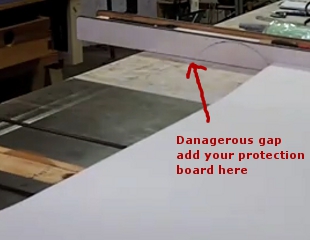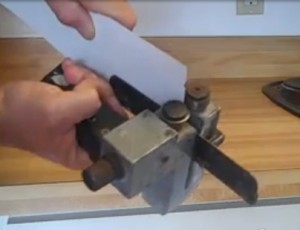Here are all of the steps:
- Cut the laminate about one inch oversize in both directions, length and width.
- Rough the surface of the cabinet or countertop that you are gluing the Formica laminate to with 40 grit sand paper.
- Apply contact glue to both surfaces and allow it to dry for about 15 minutes.
- Stick the two pieces together being careful to align them just right.
- Roll out the plastic laminate with a J-roller or you can use a block of wood and a hammer to apply the pressure that is needed.
- Apply wax or oil on the edge where the router bit will be spinning on the laminate if necessary.
- Route off the excess Formica.
- File the plastic laminate
- Clean the surface with lacquer thinner.
The process of gluing down Formica is the same whether you are laminating a cabinet, shelves, doors or countertops.
Important note: When applying plastic laminate to countertops, it is very important to always use flammable contact adhesive. If you use non-flammable contact glue, you risk the chance of the glue letting loose in the event you spill something very hot on the surface.
 The video below gives a good illustration of how to cut Formica plastic laminate on a table saw. Although the creator of the clip did an excellent job, I want to make a few important points in regard to safety.
The video below gives a good illustration of how to cut Formica plastic laminate on a table saw. Although the creator of the clip did an excellent job, I want to make a few important points in regard to safety.
Because Formica sheets are so flexible there is great risk of the sheets binding it the blade if you do not use a sharp blade. In the video there is text on the screen suggesting that you use a dull blade.
The most important rule of cutting with any tool is that the cutting instrument must be sharp.
The only time you don’t use a sharp blade is if you are cutting through a board that has a nail, staple or screw in it.
read How To Cut Laminate Sheets On A Table Saw
 There are several different ways to cut plastic laminate into strips. The most accurate tool for cutting plastic laminate edges for cabinets or countertops is called a laminate slitter. Some people use table saws for making the thin edging pieces. At times a straight edge board in combination with a router is used for milling the plastic. We often use paper cutters and also tin snips for cutting the plastic edging to length.
There are several different ways to cut plastic laminate into strips. The most accurate tool for cutting plastic laminate edges for cabinets or countertops is called a laminate slitter. Some people use table saws for making the thin edging pieces. At times a straight edge board in combination with a router is used for milling the plastic. We often use paper cutters and also tin snips for cutting the plastic edging to length.
It’s always best to cut the strips with the vertical grain being the length. This provides the most durability when you are working with the thin edges. Any time you cross-cut the grain of the sheets into thin edging, the small pieces are at risk of breaking during the gluing process. You must handle cross-cut laminate with care.
read How To Cut Plastic Laminate Strips
The process of cutting plastic laminate for door edges or counters can be done best with a plastic laminate hand slitter. It works great for making cuts on countertop-edges, backslashes, or cabinet doors. The special hand tool cost between $130 and $150. There are two adjustments that can be made to accommodate the thickness of plastic laminate and the width you need to cut.
How to Cut Plastic Laminate Edges
1)Insert the laminate against the hand slitter fence.
2)Pull with one hand while pushing with the other.
The Formica cutting tool should be adjusted so that it just barely breaks through the surface of the plastic. Then you should be able to gently twist the area that you cut with the slitter and the two pieces should separate rather easily.
read Cutting Plastic Laminate
If you have never had a plastic laminate set of cupboards , they are very durable. The worst complaints through the years about Formica have been related to the workmanship not the material the kitchens were made out of.
Well in any case, let me list for you some of the things that people have voiced they did not like about having this style of cupboard.
Particle Board Construction
Prior to the early seventies most all cabinets were fabricated using either ply-wood, pine or a combination of both. There were in some instances the use of particle board. During the mid to late seventies the use of flake-board became much more popular in the construction of Formica cabinetry. Years later as swelling began to surface due to water absorption, Formica cupboards were labeled as being cheaply made. read Complaints About Formica Cabinets


